Was I the only person who came out of watching Scott Pilgrim vs the World with the following combination on their mind?
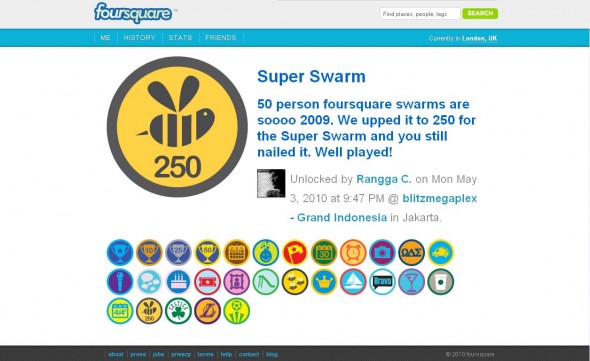
+
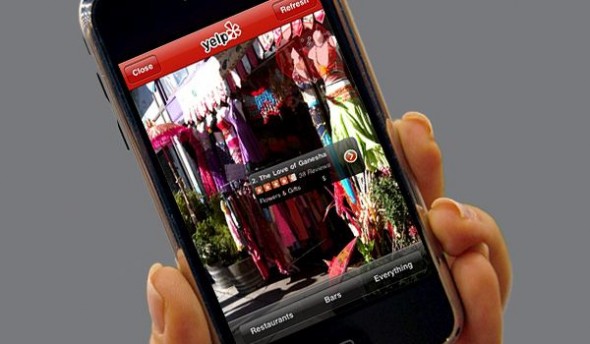
+

=
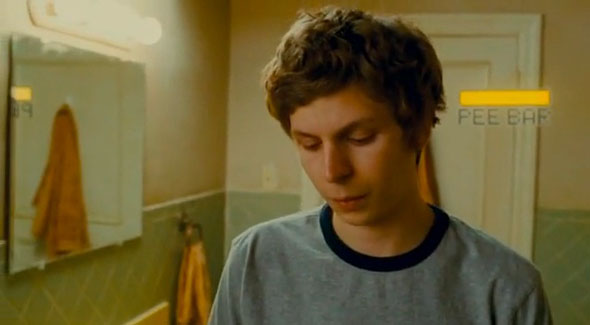
Yeah, I thought so. Although SPVTW functions as a fantastical application of video game rules and aesthetics into “real life,” I can’t help but to read it as a prescient look into the future of our increasingly videogame-ified culture. And a future where a “pee bar” hovers over someone taking a piss isn’t actually that far-fetched; in fact, most of the basic ingredients for it exist here and now.
1. Applications of video game rules to real life SPVTW’s video game aesthetic goes beyond just the surface look and feel of the movie; it’s also a commentary on how a generation brought up on video games seemingly prefers the tangible rewards system of video games to the ambiguities and dissatisfactions of adult life. This is most clearly evinced in scenes where Scott literally “gets a life” by grabbing a video game iconic representation of a “life” and where he “levels up” after accomplishing a noteworthy task:
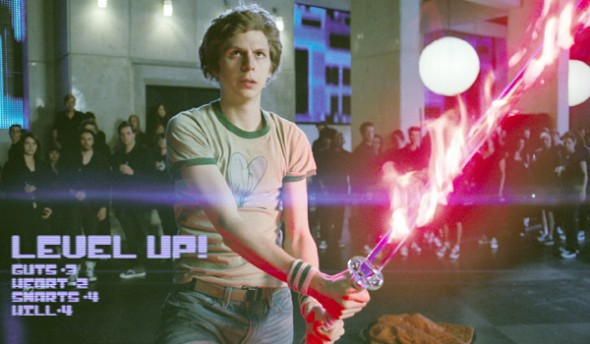
Video game developers have been aware of this for a long time, even if they weren’t aware of the now well documented studies of the physiological effects of games on the reward and motivation parts of the human brain. Recently, however, social media programmers sought to liberate these concepts from the confines of video games and their enclosed, virtual worlds and apply them to everyday life. In Foursquare, you get points for checking into restaurants, bars, etc., and you compete against your friends for earning “badges”/achievements and getting the high score of the week.

In Epic Win, you earn points from checking chores and unpleaseant tasks from your to-do list.
Earning points and unlocking levels isn’t just for Mario to do in the Mushroom Kingdom. You, Joe Shmoe, can do that in “real life” and get a slice of that same dopamine-laden satisfaction for going out to a new bar, or just taking out the garbage. Which is great, but there’s an important limitation to this game-ification of life: although all of this comes from actions performed in the “real world,” these graphical representations of achievement are limited to the abstract screenspace of a website or a smartphone app.
But that barrier is quickly disappearing, thanks to…
2. Augmented Reality
Imagine if you held your smartphone camera up to a city block and you saw all of your Foursquare or Epic Win points and achievements layered on top of the camera image. Augmented reality apps already allow smartphone users to see restaurant reviews and subway directions in this way, and it’s no big leap to imagine any other location-specific data, such as Foursquare check-ins, done in the same way.
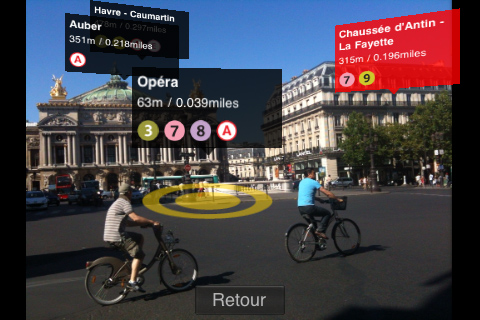
So now we’re able to merge Foursquare-esque game data with the space around us, but this is still limited to the view available on hand with a smartphone. Well, not for long…
3. Contact Lenses with Embedded LEDs

This is the last crucial barrier standing between our hum-drum normal lives and a SPVTW all-game-all-the-time existence. With LED contact lenses in your eyes, augmented reality is no longer confined to a smart phone; it’s on all the time. Of course, this concept of an always-on HUD view has been with us for a while:
 But most imaginations of these types of displays have been about fairly straightforward information display. The key leap to make here is to bring game-like data into the persistent view of the world to create the constant presence of incentive and reward, just like it is in a video game:
But most imaginations of these types of displays have been about fairly straightforward information display. The key leap to make here is to bring game-like data into the persistent view of the world to create the constant presence of incentive and reward, just like it is in a video game:
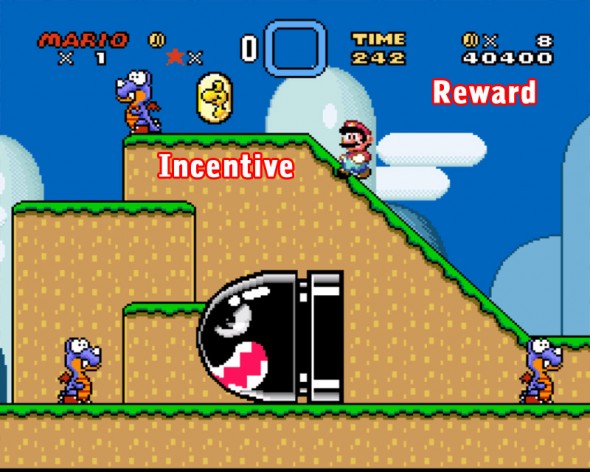
What does this all mean? Where is this going?
Let me go back to a point I made earlier: “SPVTW’s video game aesthetic goes beyond just the surface look and feel of the movie; it’s also a commentary on how a generation brought up on video games seemingly prefers the tangible rewards system of video games to the ambiguities and dissatisfactions of adult life.”
I think this will only become truer over time. Video games may take some of the blame for this, but most of this comes from the developed worlds’ shifts to service-based economies from manufacturing-based economies. When we don’t make stuff on a day to day basis, and we don’t sell our produce or shoes on the market ourselves, we become divorced both from the fruits of our labor as well as the immediate, direction connection between labor and its reward. Cranking out Excel spreadsheets in an office, collecting a steady paycheck, and living a modern, hum-drum existence can often be very boring and lacking in reward, so it’s no surprise that software developers are bringing video games and their concepts of rewards to everyday life. Foursquare may not be huge now, but it’s getting bigger every day because people are responding to this need for reward and achievement.
If given the option to augment their everyday lives and views on the world with game-like points and achievements, I think a lot of people would choose to do so. And this may not necessarily be a bad thing. Sure, many would argue that failure to find motivation, reward, and achievement in plain, unaugmented reality is in fact a failure at life, not life failing them. And that would be fair. But if the powerful reward systems of video games could be leverage to steer personal behavior in positive ways, that could make real differences in peoples’ lives that simply could not be achieved in other ways. Weight loss. Better grades. Brushing your teeth before you go to bed. Improved job performance. Would that be so bad?
 Granted, I know that such a widespread video-game-ification of real life would not be so straightforwardly positive. There’s the issue of adoption–unless the nanny state forcibly implants these LED displays in our eyes–and of course perverse incentives and gaming the system that undermine even the most well thought out scoring rubriks.
Granted, I know that such a widespread video-game-ification of real life would not be so straightforwardly positive. There’s the issue of adoption–unless the nanny state forcibly implants these LED displays in our eyes–and of course perverse incentives and gaming the system that undermine even the most well thought out scoring rubriks.
Any system of bringing video-games rules to real life, no matter how deeply embedded and well thought-out they may be, inevitably must exist apart from the messy reality it tries to bring order to. To this point, it’s important to remember that Scott Pilgrim and his video game perspective stand against, or rather, versus, The World. Sure, Scott’s video game rules help him achieve self-actualization and get the girl, but they also hindered him along the way and kept him from developing into a functioning adult.
I can’t come down firmly on the pro or con side of this hyper video game-ified augmented reality life, but I still do believe that this sort of thing is coming soon, and that we should be prepared for it when it comes. So don’t blame me when everyone around you is leveling up and leaving you behind.

There is a Ted Talk about this kind of thing by Jesse Schell. He talks about how games have started using aspects of the player’s real world, such as FaceBook games that ask you to try to convince your friends to play so you can team up and do better. Personally, any time I get a game request, I disable that game from my facebook experience, but apparently, a lot of people are playing a lot of games there. A lot of really stupid looking games. I really don’t understand it.
Schell also talks about how game experience point ideas are creeping into every day things and where this might go, taken to it’s illogical extreme. It is pretty amusing, though a little unlikely, since it poses the idea that our every action is being monitored. Given that, he mentions, not by name, but the idea of the constant gaze that Mlawski wrote about yesterday, that since one’s every action is being monitored, one might decide to try and live a better life.
http://g4tv.com/videos/44277/dice-2010-design-outside-the-box-presentation/
This revalation with video games was something that Marshall Mcluhan predicted with satlite and creating a “global theater”.
“Since Sputnik and the satellites the planet is enclosed in a man made environment that ends “Nature” and turns the globe into a repratory theater to be programmed…, The results of living inside a proscenium arch of satellites is that the young now accept the public spaces of the earth as roleplaying areas. Sensing this, they adopt costumes and roles and are ready to “do there thing ” everywhere.”
-From Cliche to Archetype Ch. 1
It makes me wonder sometimes, given the soruce material. If the reason anime was and is a near millenarian force for echo-boomers. It gave us a visions with roles and by exentsion rewarded us with souls. Specific, unique roles that recalled our video games as an extension of our own yearnings for actualization and community and it took the Japanese to figure it out and fanbioys like O’Malley to articulate in a western context.
there was a character who did this back in the old Shadowrun RPG
and stuff like this has always existed. my old mentor/weird buddy said ‘focus on your cinematography’ when living life. the big thing is iPods – you create your own soundtrack. everything is an epic in my own head. see also: parkour/free running
i’ve been arguing for ages (to nobody) that videogames will be the symbol-system of this generation, just like movies were to the last one
i’ve had Scott Pilgrim style stuff in my head for ages but it was more about music
and yes i do use FourSquare constantly – want to document my life
the other thing videogame logic is good for is documenting some psychological states. i go out heaps, and i’ve got a kinda internal progress bar – when i go out too much i end up hating humanity and needing to hide for awhile. other people i know have talked about the same thing
i once convinced a friend to take her meds by comparing them to Mario mushrooms
The first systems of control were almost entirely punitive. The Mesopotamian slave worked because of the consequences of not working. Punitive control was developed first because it is the most conspicuous and delivers immediate reinforcement to the controller. But it has long-term disadvantages. The slave may attempt to avoid the control by moving out of range or by attacking the controller. Both forms of countercontrol are as much a result of the control as the obedience it was designed to evoke. But gradually systems of control based on reinforcement have evolved. Today control is often, though obviously not exclusively, based on reinforcing the controlee rather than punishing him. Positive control was historically harder to develop, but its advantages make it increasing wide-spread today. It has several advantages, namely that it does not generate feelings of resentment or hatred in the controlee or induce counter-attack, but also, potentially, long-terms dangers. It preserves a “sense of freedom” in the controlee; as long as the controlee “feels free” he is not likely to revolt, and a system of control so well designed that it does not breed revolt may be the true threat.
-paraphrased ex tempore from B.F. Skinner
I think there’s a great movie script waiting to be written (Yes Lee, I’m looking at you!) exploring all this, a sort of Scott Pilgrim meets The Office. Or maybe you could upgrade The Office MST3000-style with the augmented pop-ups of David Brent/Michael Scott’s ‘achievements’. Looking forward to that ;-)